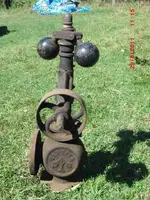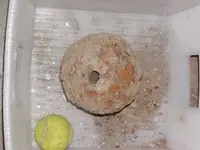MOCNOC
Tenderfoot
We're hoping someone can help us identify what appears to be an old cannonball - see photos below.
One aspect of this ball seems unusual: it has a one-inch wide open shaft running through the middle of the ball and that shaft was full of black powder.
We live just north of Cincinnati, in a small house built in 1864 by man named Charles S. Lundy. He was born in Ontario in about 1830, a grandson of William Lundy. The War of 1812's Battle of Lundy's Lane was fought on William Lundy's farm in Niagara, Ontario. We've often wondered if Charles Lundy brought the cannonball to Ohio as an odd souvenir of the war fought on his grandfather's farm.
The cannonball was unearthed in 2003 in our backyard during excavation for construction of an addition to our 1864 house. It appears to have spent much of the past 150 years in the privy pit, which also contained discarded items like broken dishes and bottles ... and two porcelain doll heads dating to the Civil War period.
The cannonball is about 5 inches in diameter and weighs about 15 pounds. It has two one-inch diameter holes directly opposite each other on the seam line. The holes are connected by an open shaft an inch wide that runs all the way through the center of the ball. There are marks visible around each hole that may show remnants of a collar of some sort surrounding at least one hole - and possibly both.
There is a mold seam that runs around the diameter of the apparently cast iron ball. There is also a circular, rough depression equidistant from the seam that we believe is a vent sprue.
There is NO hollow chamber inside the ball, just the inch-wide open shaft that runs clear through the ball. There was a quantity of black powder found inside the shaft when the ball was sent to Perryville Battlefield in Kentucky to be cleaned in 2004. We still have the powder they removed from the shaft and it looks chunky - like freeze-dried black coffee crystals. They tested the powder and it remains volatile.
The photos below show the cannonball as it looked when it was found and after it was cleaned of rust, and also the black powder that was removed from the shaft.
Have you seen another ball like this? Several experts, including some at Gettysburg, have told us the size of the ball pre-dates the American Civil War. While the Lundy's Lane origin theory fits the facts, it's also possible the ball may be related to one of Gen. Anthony Wayne's campaigns since our house is midway and on the original road between the sites of two important 18th century Northwest Territory forts - Fort Washington on the Ohio River (now Cincinnati OH) and Fort Hamilton on the Great Miami River (now Hamilton OH.)
Could it have been a solid cannonball that was later modified to carry black powder? Could it have been a bar shot? Could it have been something other than a cannonball that someone decided to fill with black powder for some reason?
Any ideas you could share would be very much appreciated.
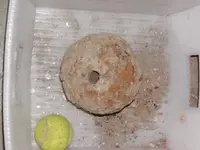
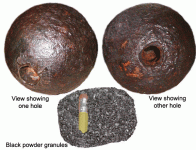
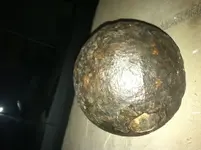
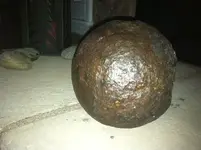
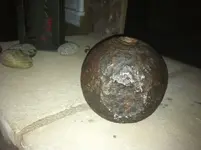
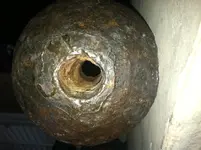
One aspect of this ball seems unusual: it has a one-inch wide open shaft running through the middle of the ball and that shaft was full of black powder.
We live just north of Cincinnati, in a small house built in 1864 by man named Charles S. Lundy. He was born in Ontario in about 1830, a grandson of William Lundy. The War of 1812's Battle of Lundy's Lane was fought on William Lundy's farm in Niagara, Ontario. We've often wondered if Charles Lundy brought the cannonball to Ohio as an odd souvenir of the war fought on his grandfather's farm.
The cannonball was unearthed in 2003 in our backyard during excavation for construction of an addition to our 1864 house. It appears to have spent much of the past 150 years in the privy pit, which also contained discarded items like broken dishes and bottles ... and two porcelain doll heads dating to the Civil War period.
The cannonball is about 5 inches in diameter and weighs about 15 pounds. It has two one-inch diameter holes directly opposite each other on the seam line. The holes are connected by an open shaft an inch wide that runs all the way through the center of the ball. There are marks visible around each hole that may show remnants of a collar of some sort surrounding at least one hole - and possibly both.
There is a mold seam that runs around the diameter of the apparently cast iron ball. There is also a circular, rough depression equidistant from the seam that we believe is a vent sprue.
There is NO hollow chamber inside the ball, just the inch-wide open shaft that runs clear through the ball. There was a quantity of black powder found inside the shaft when the ball was sent to Perryville Battlefield in Kentucky to be cleaned in 2004. We still have the powder they removed from the shaft and it looks chunky - like freeze-dried black coffee crystals. They tested the powder and it remains volatile.
The photos below show the cannonball as it looked when it was found and after it was cleaned of rust, and also the black powder that was removed from the shaft.
Have you seen another ball like this? Several experts, including some at Gettysburg, have told us the size of the ball pre-dates the American Civil War. While the Lundy's Lane origin theory fits the facts, it's also possible the ball may be related to one of Gen. Anthony Wayne's campaigns since our house is midway and on the original road between the sites of two important 18th century Northwest Territory forts - Fort Washington on the Ohio River (now Cincinnati OH) and Fort Hamilton on the Great Miami River (now Hamilton OH.)
Could it have been a solid cannonball that was later modified to carry black powder? Could it have been a bar shot? Could it have been something other than a cannonball that someone decided to fill with black powder for some reason?
Any ideas you could share would be very much appreciated.









